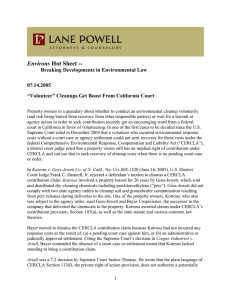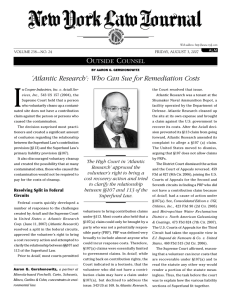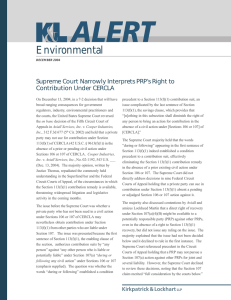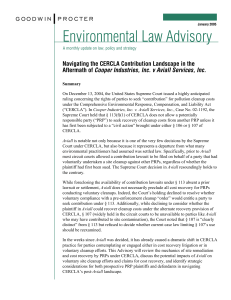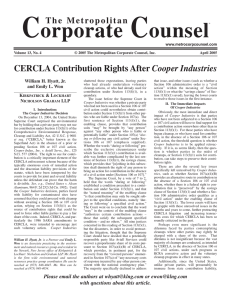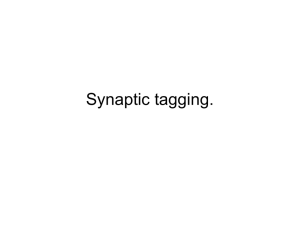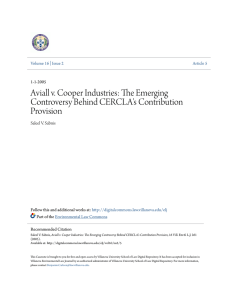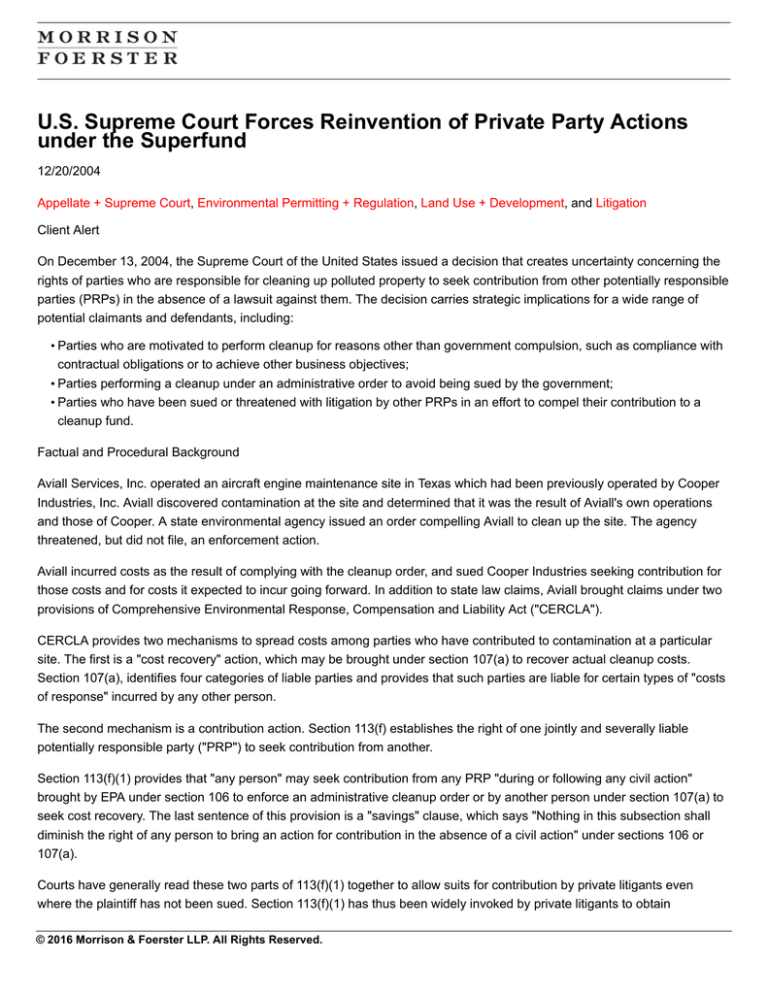
.
U.S. Supreme Court Forces Reinvention of Private Party Actions
under the Superfund
12/20/2004
Appellate + Supreme Court, Environmental Permitting + Regulation, Land Use + Development, and Litigation
Client Alert
On December 13, 2004, the Supreme Court of the United States issued a decision that creates uncertainty concerning the
rights of parties who are responsible for cleaning up polluted property to seek contribution from other potentially responsible
parties (PRPs) in the absence of a lawsuit against them. The decision carries strategic implications for a wide range of
potential claimants and defendants, including:
• Parties who are motivated to perform cleanup for reasons other than government compulsion, such as compliance with
contractual obligations or to achieve other business objectives;
• Parties performing a cleanup under an administrative order to avoid being sued by the government;
• Parties who have been sued or threatened with litigation by other PRPs in an effort to compel their contribution to a
cleanup fund.
Factual and Procedural Background
Aviall Services, Inc. operated an aircraft engine maintenance site in Texas which had been previously operated by Cooper
Industries, Inc. Aviall discovered contamination at the site and determined that it was the result of Aviall's own operations
and those of Cooper. A state environmental agency issued an order compelling Aviall to clean up the site. The agency
threatened, but did not file, an enforcement action.
Aviall incurred costs as the result of complying with the cleanup order, and sued Cooper Industries seeking contribution for
those costs and for costs it expected to incur going forward. In addition to state law claims, Aviall brought claims under two
provisions of Comprehensive Environmental Response, Compensation and Liability Act ("CERCLA").
CERCLA provides two mechanisms to spread costs among parties who have contributed to contamination at a particular
site. The first is a "cost recovery" action, which may be brought under section 107(a) to recover actual cleanup costs.
Section 107(a), identifies four categories of liable parties and provides that such parties are liable for certain types of "costs
of response" incurred by any other person.
The second mechanism is a contribution action. Section 113(f) establishes the right of one jointly and severally liable
potentially responsible party ("PRP") to seek contribution from another.
Section 113(f)(1) provides that "any person" may seek contribution from any PRP "during or following any civil action"
brought by EPA under section 106 to enforce an administrative cleanup order or by another person under section 107(a) to
seek cost recovery. The last sentence of this provision is a "savings" clause, which says "Nothing in this subsection shall
diminish the right of any person to bring an action for contribution in the absence of a civil action" under sections 106 or
107(a).
Courts have generally read these two parts of 113(f)(1) together to allow suits for contribution by private litigants even
where the plaintiff has not been sued. Section 113(f)(1) has thus been widely invoked by private litigants to obtain
© 2016 Morrison & Foerster LLP. All Rights Reserved.
.
contribution for cleanup costs they have already incurred and to receive an allocation of liability among responsible parties
for future costs. Indeed, federal and state environmental agencies have historically relied on private parties to clean up
thousands of contaminated sites "voluntarily" (i.e., without being sued by the government) and to utilize private contribution
actions to work out allocation of cleanup costs with other potentially responsible parties ("PRPs").
Another subparagraph, section 113(f)(3)(B), allows contribution actions to be brought by parties who have resolved their
liability through an administrative or a judicially approved settlement with EPA or a state.
Aviall's first claim was brought under section 107(a), the second under section 113(f)(1). To comply with Fifth Circuit
precedent in effect at the time, Aviall subsequently amended its complaint to "combine" its claims under 107(a) and 113(f)
(1). The district court interpreted this maneuver as a waiver of Aviall's independent claim under 107(a), and consequently
focused its analysis on section 113(f)(1).
The court granted summary judgment to Cooper because Aviall's contribution claim was not brought "during or following" a
civil action under section 106 or section 107(a). Aviall appealed to the United States Court of Appeals for the Fifth Circuit.
The appellate court first affirmed the district court's decision, then reversed after a rehearing en banc. Its ultimate decision
was grounded on the conclusion that both the first and last sentences of section 113(f)(1) give rise to claims for contribution.
To harmonize its conclusion with the "during or following" language in the fist sentence, the court reasoned that the word
"may" did not mean that private parties "may only" sue during or after a civil action.
The Decision
In a 7-2 opinion by Justice Clarence Thomas, the Supreme Court reversed. The Court's holding is actually fairly
straightforward. The Court held the "natural meaning" of the language of section 113(f)(1) limited contribution actions to
those filed during or after a civil action. Otherwise, the Court reasoned, contribution claims would be unrestricted, nullifying
the conditions set forth in sections 113(f)(1) and section 113(f)(3)(B). The Court rejected the argument that the savings
clause provided a separate claim, concluding that its purpose was merely to rebut any presumption that the conditions
established by 113(f)(1) would apply to contribution actions brought under other sections of CERCLA.
The immediate result of the holding in Cooper Industries is that PRPs may no longer invoke 113(f)(1) to sue other PRPs for
contribution unless they have first been subjected to a "civil action" by EPA to enforce an order issued under section 106, or
a cost recovery action brought under 107(a). While this interpretation of section 113(f)(1) marks a departure from the way in
which the section has long been applied by courts and litigants, the holding is clear. More potentially troubling are questions
that the Court acknowledged but expressly chose not to decide.
• Does section 107(a) provide a right to contribution?
The Court expressly declined to take on the issue of whether Aviall had waived any claim it may have had under section
107(a). Therefore, it did not reach the question of whether 107(a) gives rise to a claim for contribution. However, its closing
paragraphs warned the plaintiff against arguing on remand that the right to such claims is implicit in the language of 107(a).
Since the plain language of 107(a) provides the right to seek only cost recovery claims, this appears to mean that the Court
is inclined against finding an alternative mechanism to seek contribution in 107(a).
• If not, do "voluntary" PRPs have any right to recover from other PRPs under CERCLA?
© 2016 Morrison & Foerster LLP. All Rights Reserved.
.
Cooper Industries clearly shuts the door to 113(f)(1) for PRPs who have not been sued and have not entered into
administrative or judicially approved settlements with EPA or a state agency. As discussed above, the Court has also
signaled that contribution may be unavailable under 107(a).
This decision also calls into question whether CERCLA provides such PRPs with cost recovery claims. The Court
acknowledged a string of circuit court cases holding that PRP status deprives a plaintiff of the right to seek joint and several
liability against other PRPs under 107(a). However, because this issue had not been thoroughly briefed, the Court declined
to determine the correctness of these cases. Later, in a footnote, the Court also called into question the ability of PRPs
to pursue claims under 107(a) without seeking joint and several liability. If the answer to these questions is that 107(a)
provides no remedy to PRPs, the result will be that "voluntary" PRPs are cut off from any avenue to spread cleanup costs
among other liable parties.
• Is an administrative order issued by EPA under section 106 a "civil action" for purposes of 113(f)(1)?
Another question raised by this decision, although not discussed by the Court, is whether an cleanup order issued by EPA
is sufficient to trigger a right to seek contribution. In Cooper Industries, the cleanup was compelled by an order of a state
environmental agency. However, the action was viewed as "voluntary" under CERCLA because section 106 does not cover
enforcement orders by a state agency. Thus, such orders cannot trigger the right to contribution under section 113(f)(1).
The question remains whether an order issued by EPA under section 106 would qualify as a "civil action" under section
113(f)(1). If not, compliance with the order would also be considered "voluntary." Under those circumstances, a PRP may
have to refuse compliance and force a lawsuit (thereby risking treble damages) or seek an administrative settlement to
ensure its right to sue for contribution under section 113(f)(1).
Presumably, the Fifth Circuit will revisit some, if not all, of the questions raised by the Court on remand, and, unless the
parties settle first, the case may eventually make its way back to the Supreme Court. In the interim, other courts, litigants,
and environmental agencies will be left to puzzle through the outstanding questions until they are resolved through further
judicial or legislative action.
The Effects
New Pleadings
In the short term, plaintiffs and potential plaintiffs who seek contribution but have neither been sued nor entered into a
requisite settlement will likely take the precaution of drafting new complaints or amending existing ones to plead claims
under section 107(a). These claims are likely to result in a short-term burst of litigation on the questions raised by the Court
in Cooper Industries.
Friendly Lawsuits
Parties who are incurring costs pursuant to an administrative order, particularly if the order was issued by a state agency,
may request that the agency file suit. To satisfy the "civil action" requirement of section 113(f)(1), a state agency would have
to file a cost recovery action under section 107(a).
Agencies may be reluctant to commit resources to such an action, and may be uncomfortable with the concept of a "friendly
lawsuit" against alleged violators. Private parties may be similarly reluctant to force a lawsuit by refusing to comply with an
administrative order, since losing such a suit could result in the imposition of treble damages.
© 2016 Morrison & Foerster LLP. All Rights Reserved.
.
Administrative Settlements
Alternatively, parties may push for an administrative settlement to resolve the agency's claims. Agencies would likely enjoy
increased leverage in these negotiation, resulting tougher terms and higher transaction costs. However, the ability to pursue
contribution claims under section 113(f)(3) may outweigh these additional costs and burdens.
Reliance on Other Claims
Private litigants may also rely more heavily on other federal statutes, or state law claims, which could result in more cases
being tried in state courts. These claims may have different "and sometimes higher"burdens and standards of proof, and
may not offer relief as favorable as that available under CERCLA.
Legislative Relief
Given the addition burdens this decision will likely place on government environmental agencies, it is likely that agencies
and others will seek legislation to amend CERCLA and resolve these questions.
If you have questions about the Cooper Industries case, this briefing, or other issues of environmental law, please contact
Michèle Corash (415) 268-7124, Robert L. Falk (415) 268-6294, or Robin Stafford (415) 268-6674 in the San Francisco
office of Morrison & Foerster LLP, or Peter Hsiao (213)892-5731 in our Los Angeles office.
© 2016 Morrison & Foerster LLP. All Rights Reserved.

